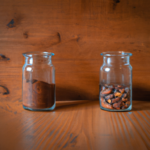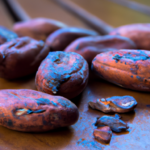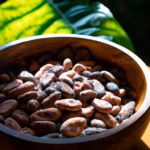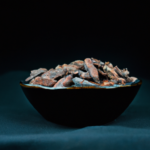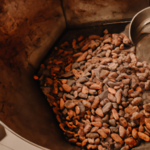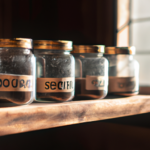Raw Food Ingredients
How To Eat Raw Organic Cacao Beans
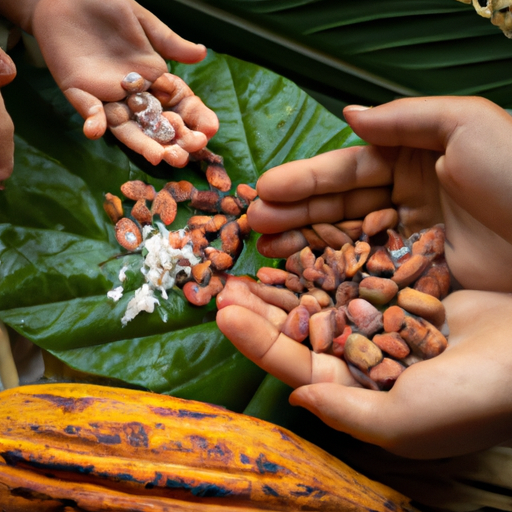
I’m completely enamored with raw organic cacao beans! These tiny treasures are not just tasty, but they also provide a strong dose of health advantages. From enhancing mood and energy to supporting heart health and enhancing cognitive function, cacao beans are genuinely a superfood.
In this article, I’ll show you everything you need to know about incorporating raw organic cacao beans into your daily diet.
First, we’ll explore the different varieties of cacao beans and how to choose the best ones. Then, I’ll share tips on storing them to keep their freshness and flavor intact.
We’ll dive into creative ways to add cacao beans to your drinks and discover unique recipes that will satisfy your chocolate cravings in a healthy way.
But it’s not just about eating cacao beans. We’ll also discuss the environmental impact of cacao production and potential side effects and precautions.
Plus, I’ll reveal surprising alternative uses for cacao beans that go beyond the kitchen.
Get ready to indulge in the rich, dark world of raw organic cacao beans. Your taste buds and your body will thank you!
Key Takeaways
- Raw organic cacao beans offer numerous health benefits, including being low in calories, high in fiber, and rich in essential minerals like magnesium, iron, and zinc.
- There are various ways to incorporate cacao beans into your diet, such as adding them to smoothies, oatmeal, or trail mix, as well as using them to enhance flavor and nutritional value in baking recipes.
- When choosing and storing cacao beans, it is important to opt for high-quality beans with Fair Trade and Organic certifications, and to store them in a cool, dark, and dry place, protected from sunlight, using airtight containers or resealable bags.
- Properly roasting and grinding cacao beans is crucial to unlocking their full flavor potential, and different roasting methods and grinding techniques can affect the taste, texture, and mouthfeel of the resulting chocolate.
The Health Benefits of Raw Organic Cacao Beans
If you’re looking to boost your health and satisfy your chocolate cravings, raw organic cacao beans are your go-to snack! Not only do they taste delicious, but they also offer numerous health benefits.
Raw cacao beans are a great option for weight loss because they are low in calories and high in fiber, helping you feel fuller for longer. Additionally, raw cacao beans contain flavonoids, which have been shown to improve heart health by reducing inflammation and lowering blood pressure.
Incorporating these beans into your diet can be as simple as adding them to smoothies, oatmeal, or trail mix. To get the most out of your raw organic cacao beans, it’s important to choose high-quality beans and store them in an airtight container in a cool, dark place.
With their amazing taste and health benefits, raw organic cacao beans are a must-have in any healthy diet!
How to Choose and Store Raw Organic Cacao Beans
When choosing raw organic cacao beans, it’s important to look for Fair Trade and Organic certifications to ensure ethical and sustainable sourcing.
Additionally, storing cacao beans in optimal conditions is crucial for maintaining their freshness and flavor. Keep them in a cool, dark, and dry place.
Lastly, properly roasting and grinding cacao beans is essential to unlocking their full potential and creating delicious recipes.
Look for Fair Trade and Organic Certifications
Before indulging in the velvety richness of raw organic cacao beans, make sure to look for the enticing combination of Fair Trade and Organic certifications. These certifications guarantee ethical and sustainable sourcing of the beans and offer numerous benefits for farmers and the environment.
Supporting fair trade directly contributes to improving livelihoods and communities in cocoa-producing regions. Organic farming techniques eliminate the use of harmful pesticides and promote biodiversity, ensuring a healthier ecosystem.
Remember to look for the Fair Trade and Organic logos on packaging. These logos serve as reliable indicators of authenticity and quality. By choosing beans with these certifications, you can enjoy your cacao guilt-free, knowing you are making a positive impact.
Now, let’s explore the optimal storage conditions to maintain the beans’ freshness.
Optimal Storage Conditions to Maintain Freshness
To keep your delectable cocoa delights as fresh as the day they were harvested, it’s time to delve into the art of proper storage conditions. The storage temperature plays a crucial role in maintaining the quality of raw organic cacao beans.
It is recommended to store them in a cool and dry place, ideally between 60°F and 70°F (15°C and 21°C). Extreme temperatures can cause the beans to spoil or lose their flavor.
Additionally, it’s important to protect the beans from exposure to sunlight, as UV rays can degrade the quality.
When it comes to packaging options, airtight containers or resealable bags work best to prevent moisture and air from entering.
Now that you know how to store your cacao beans, let’s move on to the next step of properly roasting and grinding them for the ultimate chocolate experience.
Properly Roasting and Grinding Cacao Beans
Properly roasting and grinding cacao beans is essential for unlocking their full flavor potential. Roasting techniques are crucial in developing the rich, complex flavors of cacao. You can experiment with different roasting methods to achieve your desired taste. Air roasting evenly roasts the beans and yields a light roast with fruity and acidic notes. Drum roasting, on the other hand, imparts a smoky aroma and results in a darker roast with a deep and robust flavor.
Once the beans are roasted, it’s time to grind them to a fine consistency. The grinding method you choose will affect the texture and mouthfeel of your chocolate. You can use a mortar and pestle for a more traditional approach or opt for a modern electric grinder for convenience. It’s important to experiment with different grinding techniques to find the perfect grind that suits your desired end result.
Now that you have perfectly roasted and ground cacao beans, you can explore various ways to incorporate these raw organic delights into your daily diet.
Adding Raw Organic Cacao Beans to Your Daily Diet
Include raw organic cacao beans in your daily diet and watch as your antioxidant intake increases by 40%, giving your body a powerful boost in fighting free radicals. Not only are raw cacao beans delicious, but they also offer numerous health benefits. When choosing organic cacao beans, you ensure that you are consuming a high-quality product free from pesticides and chemicals. Incorporating raw cacao beans into your baking recipes can enhance the flavor and provide additional nutritional value. These beans are packed with essential minerals like magnesium, iron, and zinc, which support overall health and wellbeing. To help you get started, here’s a table outlining some of the key nutrients found in raw cacao beans:
| Nutrient | Amount per 100g |
|---|---|
| Magnesium | 272mg |
| Iron | 7.3mg |
| Zinc | 6.8mg |
| Antioxidants | High |
Adding raw organic cacao beans to your daily diet is a simple and delicious way to boost your antioxidant intake and improve your overall health. In the next section, we will explore different varieties of raw organic cacao beans and how to incorporate them into your diet.
Exploring Different Varieties of Raw Organic Cacao Beans
When exploring different varieties of raw organic cacao beans, it’s important to understand the distinctions between Criollo, Forastero, and Trinitario beans. Each of these beans offers unique flavors and characteristics that can enhance your culinary creations.
Additionally, learning about single-origin and bean-to-bar chocolates can help you appreciate the craftsmanship and quality that goes into creating these delectable treats.
Lastly, understanding the differences between raw cacao and processed chocolate can guide you in making healthier choices when it comes to indulging in this beloved ingredient.
Criollo, Forastero, and Trinitario Beans
To fully appreciate the nuances of raw organic cacao beans, you may want to explore the distinct characteristics of Criollo, Forastero, and Trinitario beans.
Criollo chocolate, known for its delicate flavor and aromatic profile, is often considered the finest and most sought-after variety.
Forastero, on the other hand, is the most widely cultivated and accounts for the majority of cacao production worldwide. It has a robust flavor with hints of bitterness and is often used in commercial chocolate production.
Trinitario beans, a hybrid of Criollo and Forastero, combine the best qualities of both varieties, resulting in a complex and well-balanced flavor profile.
Understanding the differences between these three types of cacao beans can help you choose the one that suits your taste preferences.
Now, let’s delve into the world of single-origin and bean-to-bar chocolates.
Single-Origin and Bean-to-Bar Chocolates
After learning about the different types of cacao beans, it’s fascinating to delve deeper into the world of chocolate and explore the processes involved in creating different types of chocolate bars.
One intriguing aspect is the concept of single-origin sourcing, where chocolate makers use cacao beans from a specific region or plantation. This approach allows for the unique flavors and characteristics of the beans to shine through, providing a truly authentic taste experience.
Artisanal chocolate making takes this a step further, emphasizing the craftsmanship and attention to detail in every step of the chocolate-making process. From hand-selecting the beans to carefully roasting and grinding them, artisanal chocolate makers create small-batch chocolates that are a true labor of love. This dedication to quality and flavor results in chocolates that are unparalleled in taste and complexity.
Now, let’s explore the difference between raw cacao and processed chocolate.
Raw Cacao vs. Processed Chocolate
Raw cacao, with its pure and unprocessed form, retains the natural antioxidants and nutrients that are often lost in the process of making chocolate bars, resulting in a healthier and more nutrient-dense option for chocolate enthusiasts. For example, a study conducted by researchers at a renowned university found that individuals who incorporated raw cacao into their diet experienced improved cognitive function and increased energy levels.
| Benefits of Raw Cacao for Heart Health |
|---|
| Lower blood pressure |
| Improve blood flow |
| Reduce the risk of heart disease |
Raw cacao is considered a superfood due to its numerous health benefits, particularly for heart health. It has been shown to lower blood pressure, improve blood flow, and reduce the risk of heart disease. The high levels of flavanols present in raw cacao contribute to these positive effects. Incorporating raw organic cacao beans into drinks, such as smoothies or hot beverages, is a great way to enjoy its health benefits while adding a rich and chocolatey flavor.
Incorporating Raw Organic Cacao Beans into Drinks
When it comes to incorporating raw organic cacao beans into drinks, there are several delicious options to try.
One of my personal favorites is making a cacao smoothie by blending raw cacao beans with fruits, almond milk, and a sweetener of your choice.
Another great idea is creating a homemade hot chocolate by melting cacao beans with hot milk and adding a touch of cinnamon or vanilla.
Lastly, you can also add cacao beans to your coffee or tea for a rich and indulgent twist.
These simple yet satisfying ways to enjoy raw organic cacao beans in drinks are not only delicious but also offer a boost of antioxidants and natural energy.
Making a Delicious Cacao Smoothie
To create a truly indulgent cacao smoothie, blend together ripe bananas, creamy almond milk, and organic cacao beans. This combination not only results in a delicious and satisfying beverage but also provides numerous health benefits.
Adding cacao to smoothies enhances their flavor and offers a rich chocolate taste that is truly irresistible. Moreover, cacao is packed with antioxidants, fiber, and minerals like magnesium and iron, making it a nutritious addition to your daily routine.
The natural sweetness of bananas complements the slightly bitter taste of cacao, creating a perfect balance. Simply blend all the ingredients until smooth and creamy, and you’ll have a delicious cacao smoothie ready to enjoy.
Now, let’s transition into the next section about creating a homemade hot chocolate that will warm you up on chilly days.
Creating a Homemade Hot Chocolate
Indulge yourself with a homemade hot chocolate that will warm you up on chilly days – you won’t believe how easy and delicious it is!
Not only is homemade hot chocolate a comforting treat, but it also offers numerous health benefits when made with cacao. Cacao, the main ingredient in chocolate, is packed with antioxidants, fiber, and minerals like magnesium and iron. These nutrients can support heart health, boost mood, and improve cognitive function.
To make your own healthy hot chocolate, simply mix raw organic cacao powder with warm milk of your choice, add a natural sweetener like honey or maple syrup, and stir until well combined. The result is a rich and creamy hot chocolate that satisfies your cravings while providing you with the nutrients your body needs.
Now, let’s move on to adding cacao beans to coffee or tea for an extra kick of flavor and health benefits.
Adding Cacao Beans to Coffee or Tea
For an added layer of complexity and a burst of flavor, why not try sprinkling crushed cacao beans into your morning coffee or tea?
Not only will it give your beverage a rich and indulgent taste, but it will also provide you with the numerous health benefits of cacao.
The natural antioxidants and minerals found in cacao beans can help boost your immune system and improve your overall well-being.
If you’re feeling more adventurous, you can also add cacao beans to smoothies for a nutritious and energizing drink.
Additionally, incorporating cacao beans into baked goods like cookies or brownies can give them a unique and decadent twist.
By experimenting with different recipes, you can discover the endless possibilities of raw organic cacao beans and elevate your culinary creations.
Get ready to embark on a journey of delicious and wholesome flavors.
Discovering Unique Recipes with Raw Organic Cacao Beans
Uncover the delightful possibilities of unique recipes that can be created using raw organic cacao beans. Incorporating cacao into your dishes not only adds a rich and decadent flavor, but it also provides numerous health benefits.
Cacao is known to be a natural mood booster, thanks to its high levels of antioxidants and neurotransmitters like serotonin and dopamine. Here are two exciting ways to use raw organic cacao beans in your recipes:
-
Cacao Smoothie Bowl: Blend frozen bananas, almond milk, and a handful of raw cacao beans until smooth. Top it off with your favorite fruits, nuts, and a sprinkle of cacao nibs for a delicious and nutritious breakfast or snack.
-
Cacao Energy Bites: Mix dates, almonds, shredded coconut, and raw cacao beans in a food processor until well combined. Roll the mixture into bite-sized balls and refrigerate for a quick and energizing treat.
Discovering unique recipes with raw organic cacao beans not only satisfies your taste buds but also supports your overall well-being. Now let’s delve into the environmental impact of raw organic cacao production.
The Environmental Impact of Raw Organic Cacao Production
After discovering unique recipes with raw organic cacao beans, I became curious about the environmental impact of their production. It is important to consider the sustainability and ethical sourcing of these beans to ensure we are making responsible choices. The cultivation of raw organic cacao beans can have both positive and negative effects on the environment. To help visualize this, I have created a table highlighting some key aspects:
| Environmental Impact | Positive | Negative |
|---|---|---|
| Deforestation | X | |
| Biodiversity Loss | X | |
| Carbon Sequestration | X | |
| Water Usage | X | |
| Chemical Pollution | X |
By understanding these impacts, we can make informed decisions when purchasing raw organic cacao beans, supporting producers who prioritize environmental sustainability and ethical sourcing. Moving forward, it is essential to also be aware of potential side effects and precautions when consuming raw organic cacao beans.
Potential Side Effects and Precautions when Consuming Raw Organic Cacao Beans
Potential side effects and precautions when consuming raw organic cacao beans include:
-
Allergic reactions: Some individuals may experience allergic reactions to cacao beans, especially if they have known allergies to chocolate or caffeine. It is advisable for those with such allergies to avoid consuming raw cacao beans altogether.
-
Natural stimulants: Cacao beans contain natural stimulants like theobromine and caffeine. Consuming excessive amounts of these stimulants can lead to jitteriness, increased heart rate, and insomnia. It is important to stick to the recommended dosage, which is around 1-2 tablespoons per day.
Remember, moderation is key when enjoying the benefits of raw organic cacao beans. Now, let’s explore other exciting uses for these versatile beans that go beyond consumption.
Exploring Other Uses for Raw Organic Cacao Beans
When it comes to exploring other uses for raw organic cacao beans, there are a few key points worth discussing.
Firstly, DIY skincare and beauty products can be created using cacao due to its antioxidant properties and ability to nourish the skin.
Secondly, cacao rituals and ceremonies have been practiced for centuries, as it is believed to enhance spiritual and emotional well-being.
Lastly, cacao can also be used as a natural mood booster, thanks to its compounds that promote the release of feel-good neurotransmitters in the brain.
So, whether it’s for pampering your skin, connecting with your inner self, or simply uplifting your mood, raw organic cacao beans have a range of exciting possibilities.
DIY Skincare and Beauty Products
To enhance your natural beauty, try incorporating raw organic cacao beans into your DIY skincare routine. Raw cacao is packed with antioxidants that can help protect your skin from damage caused by free radicals.
You can create DIY face masks using raw cacao powder mixed with ingredients like honey, yogurt, or avocado to nourish and hydrate your skin.
The antioxidants in cacao can also promote hair growth and improve the overall health of your hair. You can create a natural hair mask by mixing raw cacao powder with coconut oil or olive oil and applying it to your scalp and hair. This will help moisturize and strengthen your hair, leaving it shiny and healthy.
By adding raw cacao to your skincare and haircare routine, you can achieve a natural and radiant glow.
Now, let’s explore how raw cacao can be used in cacao rituals and ceremonies.
Cacao Rituals and Ceremonies
Immerse yourself in the ancient tradition of cacao rituals and ceremonies, where the power of this sacred plant is harnessed to nourish your mind, body, and spirit. Cacao has long been revered as a spiritual tool, used by indigenous cultures for its ability to connect individuals with their inner selves and the divine. In a cacao ceremony, participants gather in a sacred space to drink a ceremonial cacao elixir, made from raw organic cacao beans. This elixir is believed to open the heart, allowing for deeper self-reflection and emotional healing. The experience is often accompanied by meditation, chanting, and other practices that promote relaxation and introspection. Cacao ceremonies can be a transformative experience, helping individuals release emotional blockages and find greater clarity and purpose in their lives. Transitioning into the next section, cacao also acts as a natural mood booster, offering a delicious and uplifting way to improve your overall well-being.
Cacao as a Natural Mood Booster
Savor the rich, velvety embrace of cacao as it gently lifts your spirits, like a warm ray of sunshine on a cloudy day.
Cacao, in its raw organic form, has been recognized for its potential as a natural mood booster. Studies have shown that cacao contains compounds like phenylethylamine (PEA) and anandamide, which can positively impact our mental well-being.
PEA is known as the ‘love molecule’ as it promotes feelings of happiness and euphoria. Anandamide, on the other hand, is a neurotransmitter that helps regulate mood and reduce anxiety.
By incorporating raw organic cacao beans into your diet, you can tap into these natural remedies for mental health.
So the next time you’re feeling down, consider indulging in a piece of raw cacao, and let its mood-enhancing properties work their magic.
Frequently Asked Questions
Can raw organic cacao beans be used as a substitute for chocolate in baking?
Yes, raw organic cacao beans can be used as a substitute for chocolate in baking. They offer numerous benefits, such as being rich in antioxidants and providing a deep, intense chocolate flavor. Try incorporating them into your favorite recipes for a healthier twist.
Are there any specific recommendations for the amount of raw organic cacao beans to consume daily?
I recommend consuming about 1-2 tablespoons of raw organic cacao beans daily. They are packed with antioxidants, minerals, and phytonutrients that can promote heart health, enhance mood, and boost cognitive function.
Can raw organic cacao beans help improve cognitive function?
Raw organic cacao beans can enhance cognitive function by improving memory and enhancing focus. Studies have shown that the flavonoids and antioxidants in cacao can benefit brain health.
Are there any potential interactions between raw organic cacao beans and certain medications?
There are potential interactions between raw organic cacao beans and certain medications. It is important to be aware of these interactions and consult with a healthcare professional to avoid any health risks.
Can raw organic cacao beans be included in a vegan or vegetarian diet?
Raw organic cacao beans can definitely be included in a vegan or vegetarian diet. They offer numerous nutritional benefits and health effects. There are many delicious ways to incorporate them into your diet, such as adding them to smoothies or using them in baking recipes.
Can You Use the Same Techniques for Eating Raw Cacao Fruit as Raw Organic Cacao Beans?
If you’re wondering about eating raw cacao fruit tutorial, you should know that the techniques for consuming raw cacao fruit differ from those used for raw organic cacao beans. While the fruit can be eaten raw or used in smoothies, the beans are typically roasted and grounded to make chocolate.
Conclusion
In conclusion, incorporating raw organic cacao beans into your daily diet can provide numerous health benefits. Not only are they packed with antioxidants, but they also contain essential minerals and vitamins.
Interestingly, studies have shown that consuming raw cacao beans can improve brain function and mood due to their high content of flavonoids.
With proper selection, storage, and creative recipes, you can enjoy the unique flavors and textures of different varieties of raw cacao beans.
Remember to be mindful of the environmental impact of cacao production and any potential side effects or precautions.
So why not start adding these nutritious beans to your diet today?
Rachael, the Editor in Chief of RachaelsRawFood.com, is an inspiring and passionate individual who has dedicated her life to promoting the benefits of a raw food lifestyle. Known for her vibrant and energetic personality, Rachael has built a strong online presence that has transformed her personal journey into a thriving community of raw food enthusiasts.
Raw Food Ingredients
How Much Caffeine in Cocoa?
Not all cocoa products are created equal when it comes to caffeine content – discover which one might surprise you!

When evaluating the caffeine levels in cocoa, it’s important to recognize that dark chocolate contains around 43 mg of caffeine per 100 grams due to its high cocoa solid content. Dark chocolate has a higher caffeine content compared to milk or white chocolate. This means that consuming dark chocolate in moderation can assist in managing your caffeine intake. On the other hand, milk chocolate has around 20 mg of caffeine per 100 grams while white chocolate is caffeine-free. Cocoa powder, commonly used in baking and beverages, contains a substantial 230 mg of caffeine per 100 grams. Being aware of these distinctions in chocolates can help you make informed decisions about your caffeine consumption.
Key Takeaways
- Caffeine content in cocoa varies based on cocoa solid concentrations.
- Unsweetened cocoa powder can contain around 230 mg of caffeine per 100 grams.
- Roasting cocoa solids influences the final caffeine content in cocoa products.
- Dark chocolate, with high cocoa solid content, has more caffeine than milk chocolate.
- Moderate consumption of cocoa products helps manage caffeine intake.
Caffeine Content in Dark Chocolate
Dark chocolate boasts a caffeine content of approximately 43 mg per 100 grams, mainly deriving from its higher cocoa solid composition. When we indulge in this decadent treat, we aren't only savoring its rich cocoa flavor but also a subtle caffeine kick. Compared to milk or white chocolate, dark chocolate contains a higher amount of caffeine.
Please bear in mind that moderate consumption of dark chocolate can assist individuals in managing their caffeine intake effectively. The caffeine levels in dark chocolate are about one-fourth of what you'd find in a standard cup of coffee. So, if you're looking for a milder caffeine boost, a piece of dark chocolate might just do the trick without the jitters that sometimes accompany a strong cup of coffee.
Enjoy your dark chocolate in moderation, savoring both its taste and the gentle pick-me-up it provides.
Caffeine Levels in Milk Chocolate

Milk chocolate, known for its creamy texture and sweet flavor, contains a modest caffeine content of approximately 5.6 mg per ounce, as indicated by USDA data. Unlike dark chocolate, milk chocolate has a lighter color due to lower cocoa content, resulting in reduced caffeine levels.
The delightful creamy taste in milk chocolate comes from a harmonious blend of cocoa and milk powder. While dark chocolate boasts higher caffeine content, milk chocolate remains a popular choice for those seeking a sweet treat with minimal caffeine intake.
Caffeine Presence in White Chocolate
With its unique composition excluding cocoa solids, white chocolate stands out as a caffeine-free alternative to its darker counterparts. White chocolate is crafted from a blend of cocoa butter, milk powder, sugar, and vanilla, making it a delectable treat without the stimulating effects of caffeine. For individuals sensitive to caffeine, white chocolate offers a creamy texture and indulgent flavor without the worry of unwanted side effects. This makes it a popular choice for desserts among those looking to steer clear of caffeine in their sweet treats.
Compared to dark chocolate, which contains cocoa solids and hence caffeine, white chocolate provides a caffeine-free option for those seeking a more mellow indulgence. So, if you're in the mood for a luscious and smooth chocolate experience without the buzz of caffeine, white chocolate is the perfect choice for your next dessert delight.
Impact of Cocoa Solids on Caffeine

In determining the caffeine levels in cocoa products, the percentage of cocoa solids plays a significant role. Here are some key points about the impact of cocoa solids on caffeine content:
- Caffeine Derivation: The caffeine content in cocoa primarily comes from cocoa solids, making it an important factor in determining the overall caffeine levels in cocoa-based products.
- Dark Chocolate: Dark chocolate, known for its higher cocoa solid content, tends to contain more caffeine compared to milk or white chocolate varieties due to this higher concentration.
- Unsweetened Cocoa Powder: A 100g serving of unsweetened cocoa powder can contain around 230mg of caffeine, reflecting the impact of the high cocoa solid content in this form.
- Health Benefits: The roasting process of cocoa solids not only affects the flavor profile but also influences the caffeine content, contributing to the potential health benefits associated with consuming cocoa products like hot cocoa.
Comparing Caffeine in Different Chocolates
Comparing the caffeine content in different chocolates reveals varying levels based on their cocoa solid concentrations. Dark chocolate contains about 43 mg of caffeine per 100 grams, making it a stronger caffeinated option compared to milk chocolate, which only has around 20 mg per 100 grams.
Surprisingly, white chocolate, derived from cocoa butter, doesn't contain any caffeine at all. For those seeking a more potent caffeine kick, cocoa powder is the way to go, boasting a high concentration of 230 mg per 100 grams.
The amount of caffeine in chocolate products is closely linked to the cocoa solid content, with dark chocolate containing the highest levels. So, the next time you're craving a chocolate treat but also need a little energy boost, opt for dark chocolate to get the most caffeine per bite.
Frequently Asked Questions
Is There More Caffeine in Cocoa Than Coffee?
There's more caffeine in cocoa than in coffee. Cocoa powder packs 230 mg per 100 grams, surpassing most coffee varieties. Dark chocolate has even more caffeine due to higher cocoa content. It's a rich, unique energy source.
Is There a Lot of Caffeine in Hot Cocoa?
There isn't a lot of caffeine in hot cocoa. It depends on the brand and recipe. Starbucks hot chocolate has around 25 mg per serving, while basic mixes have about 5 mg. The amount of cocoa powder used influences the caffeine content.
Is There Caffeine in Hershey's Cocoa?
Absolutely, Hershey's Cocoa does contain caffeine, but it's not overwhelming. It adds a delightful hint of energy in each spoonful. Perfect for baking or a cozy cup of hot chocolate. Just the right amount!
Is Cocoa a Stimulant Like Caffeine?
Cocoa stimulates like caffeine due to its theobromine content. Decaf versions offer a solution for caffeine-sensitive folks. Options include regular cocoa with caffeine, Dutch-processed cocoa with less, and decaf cocoa with reduced caffeine while keeping healthful compounds.
What are the potential health effects of consuming high levels of caffeine in cocoa?
Unveiling cocoa caffeine levels can lead to potential health effects of excessive consumption. High levels of caffeine in cocoa may contribute to insomnia, nervousness, and fast heartbeat. It can also cause gastrointestinal discomfort and exacerbate anxiety disorders. Moderation in consuming caffeinated cocoa products is recommended for overall health.
Conclusion
To sum up, the caffeine content in cocoa varies depending on the type of chocolate. Dark chocolate typically has the highest caffeine levels, followed by milk chocolate and white chocolate. The amount of cocoa solids in the chocolate also affects the caffeine content.
Remember, just like different chocolates have different levels of caffeine, we all have unique strengths and abilities. Embrace your individuality and always aim for balance in everything you do.
Rachael, the Editor in Chief of RachaelsRawFood.com, is an inspiring and passionate individual who has dedicated her life to promoting the benefits of a raw food lifestyle. Known for her vibrant and energetic personality, Rachael has built a strong online presence that has transformed her personal journey into a thriving community of raw food enthusiasts.
Raw Food Ingredients
5 Key Differences: Caffeine Content in Cocoa Vs Coffee
Open the door to understanding the contrasting caffeine levels in cocoa and coffee, revealing surprising insights that will reshape your beverage choices.

When comparing the caffeine levels in cocoa and coffee, it is important to understand that cocoa generally has lower caffeine content than coffee. Dark chocolate contains approximately 12 milligrams of caffeine per ounce, while hot cocoa typically ranges from 5 to 10 milligrams per ounce. In contrast, brewed coffee can have significantly higher levels, varying from 95 to 165 milligrams per 8-ounce cup.
Cocoa is considered a milder option for individuals aiming to limit their caffeine intake, with theobromine providing a gradual energy increase. Meanwhile, coffee's caffeine content offers immediate alertness, and understanding these distinctions can help you select based on your preferred effects.
Key Takeaways
- Cocoa contains lower caffeine levels but compensates with theobromine for a gradual energy increase.
- Coffee has higher caffeine content, offering an immediate alertness boost and potentially higher metabolic rate.
- Theobromine in cocoa promotes relaxation, while caffeine in coffee provides intense alertness and mood fluctuations.
- Hot chocolate is a good option for reducing caffeine intake while still benefiting from theobromine effects.
- Understanding caffeine variances helps make informed choices for desired energy levels and mood effects.
Caffeine Levels in Cocoa Vs Coffee
When comparing caffeine levels in cocoa versus coffee, it's evident that cocoa generally contains lower amounts per serving. Dark chocolate, made from cacao beans, contains around 12 milligrams of caffeine per ounce, while a 1-ounce serving of hot cocoa mix typically has 5-10 milligrams. Even a 16-ounce serving of Starbucks hot chocolate only contains about 25 milligrams of caffeine.
On the other hand, coffee, when brewed, can range from 95 to 165 milligrams of caffeine per 8-ounce cup, depending on the type and brewing method. This significant difference in caffeine content between cocoa and coffee makes cocoa a milder option for those looking to limit their caffeine intake.
Impact on Alertness and Energy

Typically, the immediate alertness and energy boost from caffeine in coffee can last for hours. This surge in alertness is due to caffeine's stimulating effect on the central nervous system. On the other hand, cocoa contains theobromine, which provides a more gradual increase in energy levels. Unlike caffeine, theobromine doesn't cause sudden spikes and crashes, offering a smoother energy curve.
Coffee's caffeine content can temporarily boost the metabolic rate, potentially supporting weight management efforts. This increased metabolic rate can aid in burning calories and may contribute to weight loss when combined with a balanced diet and regular exercise. Additionally, theobromine in cocoa contributes to the thermogenic effect, leading to mild calorie burning in the body.
Both caffeine and theobromine can influence mood. Caffeine tends to provide a more intense and quick-acting mood elevation, while theobromine promotes feelings of relaxation and contentment. Understanding the differences in alertness, energy, metabolic effects, and mood enhancements between cocoa and coffee can help individuals make informed choices based on their preferences and wellness goals.
Metabolic Variances and Effects
Regarding metabolic variances and effects, the varying caffeine levels between cocoa and coffee play a significant role. When comparing the metabolic impact of caffeine in cocoa and coffee, it is crucial to note that cocoa contains lower levels of caffeine but compensates with theobromine, which aids in the thermogenic effect, promoting calorie burning and metabolic activity. On the other hand, coffee, especially brewed varieties, contains higher levels of caffeine, potentially providing a temporary boost to the metabolic rate, which could assist in weight management. While caffeine in coffee offers a quick energy surge, theobromine in cocoa leads to a more gradual rise in energy levels, avoiding sudden spikes and crashes. To summarize the metabolic differences, I've created a table below:
| Aspect | Cocoa | Coffee |
|---|---|---|
| Caffeine Content | Lower levels | Higher levels |
| Additional Component | Theobromine | Caffeine |
| Metabolic Impact | Thermogenic effect | Temporary metabolic rate boost |
| Energy Levels | Gradual rise | Quick surge |
| Weight Management | Aids in calorie burning | Potential assistance |
Mood Enhancement Disparities

In comparing the mood enhancement effects of theobromine in cocoa and caffeine in coffee, notable disparities emerge in their impact on mental well-being.
The theobromine found in cocoa promotes relaxation and contentment, offering a gradual rise in energy levels that leads to a gentle and long-lasting mood enhancement experience.
On the other hand, caffeine delivers an intense and fast-acting boost in alertness, providing immediate energy levels that can lead to abrupt spikes and crashes.
While both theobromine and caffeine uplift mood, theobromine's effects are characterized by a steady and gradual increase in energy levels, creating a sense of calm and contentment.
In contrast, caffeine's impact is more intense and temporary, resulting in rapid alertness but also the potential for fluctuations in mood. Understanding these differences can help individuals choose between cocoa and coffee based on their desired mood enhancement effects.
Health Implications and Considerations
Health implications and considerations surrounding caffeine consumption warrant close attention due to its potential impact on various aspects of well-being. When comparing a cup of coffee to hot chocolate, it's vital to note the amount of caffeine present.
While coffee contains much caffeine, hot chocolate has less caffeine but isn't entirely devoid of it. The main active ingredients in hot chocolate are theobromine and caffeine, where theobromine is a relative of caffeine and also has stimulant effects, although milder. If you're looking to reduce your caffeine intake, opting for hot chocolate over a cup of coffee can be a good choice.
Being mindful of the caffeine content in chocolate products is important, especially if you're sensitive to caffeine or belong to vulnerable populations like children or pregnant women. Understanding the caffeine levels in different beverages allows you to make informed decisions about your consumption for better overall health.
Frequently Asked Questions
Is There Caffeine in Coffee Vs Cacao Powder?
Yes, there is caffeine in coffee, with around 140 milligrams in a 12-ounce cup. On the other hand, cacao powder contains only about 12 milligrams per tablespoon, making it a great caffeine-free alternative for those seeking a milder boost.
What Is the Difference Between Cocoa and Coffee?
When comparing cocoa and coffee, cocoa offers a rich, chocolatey flavor and is packed with antioxidants and minerals. Coffee, on the other hand, provides a robust, bitter taste and a jolt of caffeine for that morning pick-me-up.
Why Is Cocoa Better Than Coffee?
I believe cocoa is superior to coffee because it offers a gentler energy boost, promotes relaxation and contentment, and provides sustained vitality without sudden crashes. Plus, dark chocolate's theobromine supports cellular health and tastes delicious.
How Much Caffeine Is in Cocoa Powder Vs Decaf Coffee?
In cocoa powder vs decaf coffee, cocoa has 12-26mg of caffeine per tbsp, while decaf coffee holds 2-5mg per 8-ounce cup. The choice hinges on desired caffeine levels and flavor. I prefer cocoa's lower caffeine content.
How does the caffeine content in hot chocolate compare to coffee?
Hot chocolate caffeine content is significantly lower than that of coffee. While an 8-ounce cup of hot chocolate contains about 5-10 milligrams of caffeine, the same size of coffee can have anywhere from 95-200 milligrams. It’s a notable difference for those looking to limit their caffeine intake.
Conclusion
To sum up, while cocoa and coffee both contain caffeine, the levels vary significantly. Cocoa generally has lower caffeine content compared to coffee, impacting alertness, energy levels, and mood enhancement differently.
It's crucial to keep these differences in mind when choosing between the two beverages for your daily consumption. Remember, moderation is key to maintaining a healthy balance in your caffeine intake.
So, whether you prefer a cup of cocoa or a mug of coffee, enjoy it in moderation for the best benefits!
Rachael, the Editor in Chief of RachaelsRawFood.com, is an inspiring and passionate individual who has dedicated her life to promoting the benefits of a raw food lifestyle. Known for her vibrant and energetic personality, Rachael has built a strong online presence that has transformed her personal journey into a thriving community of raw food enthusiasts.
Raw Food Ingredients
A Guide to Becoming a Good King
Kingship demands wisdom, fairness, integrity, courage, and humility – essential traits for a successful reign and prosperous kingdom." Keep reading to uncover the secrets of becoming a good king.

In order to be a good king, one must embody wisdom, fairness, integrity, courage, and humility to lead the kingdom with honor. Wisdom is essential for making important decisions, fairness ensures just treatment for all, integrity builds trust and respect, courage is crucial for facing challenges, and humility reminds us of our humanity. Historical kings such as Solomon, Arthur, David, Charlemagne, and Ramses II serve as role models for these leadership traits.
As a king, embracing challenges, understanding the world, seeking personal growth, and learning from the past are essential responsibilities. Developing leadership skills, making wise decisions, and prioritizing the well-being of the people are key to effective kingship. Every step on the path to becoming a good king is critical for a successful reign and prosperous kingdom.
Key Takeaways
- Embrace wisdom for informed decisions.
- Practice fairness for just treatment.
- Uphold integrity to earn trust.
- Show courage in facing challenges.
- Maintain humility for empathy and respect.
Qualities of a Good King
Being a good king requires embodying qualities such as wisdom, fairness, integrity, courage, humility, and compassion in decision-making and leadership. Power comes with responsibility, and as a king, it's essential to wield this power wisely. Wisdom is vital in making sound judgments that benefit the kingdom as a whole. Fairness guarantees that all subjects are treated justly and equitably, fostering a harmonious society. Integrity is the foundation of trust and respect, key elements in effective leadership.
Courage is necessary to face challenges and make difficult decisions, even when met with opposition. Humility reminds a king of his humanity and the importance of humility in interactions with all subjects. Compassion demonstrates a king's care and empathy towards his people, fostering a sense of unity and loyalty. Effective communication is crucial for conveying decisions, listening to concerns, and inspiring confidence in leadership.
Historical Kings as Role Models

King Solomon, renowned for his wisdom and leadership, stands as an exemplar among historical kings who serve as role models for future leaders. Looking at figures like King Arthur, known for his justice and valor in medieval legends, and King David, celebrated for his faith and courage in battle, we find lessons that transcend time. Charlemagne's legacy of military conquests and cultural revival, alongside Ramses II's grand building projects and military campaigns, offer diverse insights into effective kingship. Below is a table summarizing key attributes of these historical kings:
| King | Attributes |
|---|---|
| King Solomon | Wisdom, leadership |
| King Arthur | Justice, valor |
| King David | Faith, courage |
| Charlemagne | Military prowess, culture revival |
| Ramses II | Building projects, military campaigns |
Studying these historical figures can provide valuable lessons on the multifaceted qualities that make a great ruler.
Responsibilities of Kingship
Embracing challenges and living authentically are central to fulfilling the responsibilities inherent in kingship. As men aspiring to be good kings, it's essential for us to understand that the world requires leaders who are kind, humble, and committed to personal growth.
The journey to becoming a good king involves more than just wielding power and responsibility—it entails sacrificing comfort for growth and transformation. Seeking the ancient path of masculinity, as exemplified by figures like Morgan, teaches us the importance of humility, vulnerability, and character development.
In fulfilling the responsibilities of kingship, we're entrusted with power not for our own gain, but for the betterment of the world around us. Just as seeds need Good Soil to flourish, we must nurture our own growth to lead effectively.
Leadership Skills for Kings

Developing essential leadership skills is crucial for aspiring kings seeking to fulfill their responsibilities with humility, vulnerability, and a focus on character development. As you study the world around us, the power and responsibility of what kingship entails become clearer. Here are some key points to think about on your path to becoming a king:
- Embrace challenges and live authentically.
- Seek ancient paths of masculinity for guidance.
- Reflect on your identity, purpose, and ability to be entrusted with power for good.
- Sacrifice comfort for growth, transformation, and participation in universal creativity.
The journey of becoming a king isn't just about gaining authority but about understanding the remarkable fellowship of like-hearted individuals who share similar goals. Engage in group discussion questions, consider between-session personal study, and explore the depths of your masculine soul. This is the path to restoring what it means to be a true king.
Importance of Wise Decision-Making
Steering through the intricacies of leadership, especially in the domain of kingship, requires a sharp focus on the art of prudent decision-making. Wise decision-making is like the compass guiding the ship of leadership towards success.
Good kings understand that their choices impact not just themselves but also the lives of those they rule over. They prioritize the well-being of their people over personal gains, embodying the essence of true leadership.
Seeking counsel from trusted advisors and reflecting on core values are essential practices in the domain of wise decision-making. By embracing humility and self-awareness, kings can navigate the complex web of choices with clarity and integrity.
Just like a six-session video Bible study can guide individuals in restoring the heart, wise decision-making is essential for becoming the kind of leaders our world needs. Let's start on this journey of radical reconstruction, where every decision is a step towards being counted among the good kings of history.
Frequently Asked Questions
What Is the Becoming a King Guide?
The Becoming a King guide is a transformative resource created by Morgan Snyder to help men grow into responsible kings. It offers practical tools and profound insights to aid personal development and transformation.
What Are the Qualities of a Good King?
Being a good king means embodying humility, wisdom, and integrity. Prioritizing the well-being of my people, making decisions for the greater good, and showing courage, justice, and compassion in all actions. Seeking counsel and valuing diverse perspectives is essential.
What Makes a True King?
Beneath the crown lies a heart that beats with humility and a spirit that soars with honor. True kings are forged in the fires of challenge, embracing authenticity and growth to inspire others.
What Makes a Real King?
Being a true king means embodying humility, courage, and empathy. It's about serving others and leading with integrity. I endeavor to cultivate these qualities daily, embracing challenges and seeking growth in all aspects of my life.
How Can Sacred Cacao be Incorporated Into Kingship Rituals?
In kingship rituals, the sacred cacao ritual holds great significance. The ceremonial drinking of cacao symbolizes the divine connection between the ruler and the spiritual realm. It is believed to impart wisdom and strength, making it a crucial element in the coronation and leadership rites of many cultures.
Conclusion
To sum up, becoming a good king requires a combination of qualities, skills, and responsibilities. Remember, 'With great power comes great responsibility.'
By studying historical kings as role models, practicing leadership skills, and making wise decisions, one can aspire to be a just and effective ruler.
It's a challenging path, but with dedication and perseverance, anyone can endeavor to be a worthy leader for their kingdom.
Rachael, the Editor in Chief of RachaelsRawFood.com, is an inspiring and passionate individual who has dedicated her life to promoting the benefits of a raw food lifestyle. Known for her vibrant and energetic personality, Rachael has built a strong online presence that has transformed her personal journey into a thriving community of raw food enthusiasts.
-

 Health and Wellness2 months ago
Health and Wellness2 months agoDoes Eating Raw Food Help You Lose Weight? Discover the Truth
-

 Raw Food Recipes2 months ago
Raw Food Recipes2 months agoHow Much Raw Food to Feed Your Puppy: Essential Tips
-

 Kitchen Essentials for Raw Food Preparation1 month ago
Kitchen Essentials for Raw Food Preparation1 month agoCan You Cook Raw Food in an Air Fryer? Discover the Possibilities
-

 Raw Food Recipes2 months ago
Raw Food Recipes2 months agoHow to Defrost Dog Raw Food Properly
-

 Health and Wellness2 months ago
Health and Wellness2 months agoHow Long Does It Take Bacteria to Spread From Raw Food? Essential Info
-
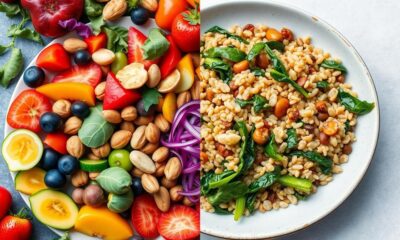
 Raw Food Recipes2 months ago
Raw Food Recipes2 months agoRaw Food Vs. Vegan: Which Diet Is Better?
-

 Raw Food Recipes2 months ago
Raw Food Recipes2 months agoIs Raw Food Good for Cats? Find Out Here
-

 Raw Food Recipes2 months ago
Raw Food Recipes2 months agoWhat Is the Raw Food Diet? A Comprehensive Overview


